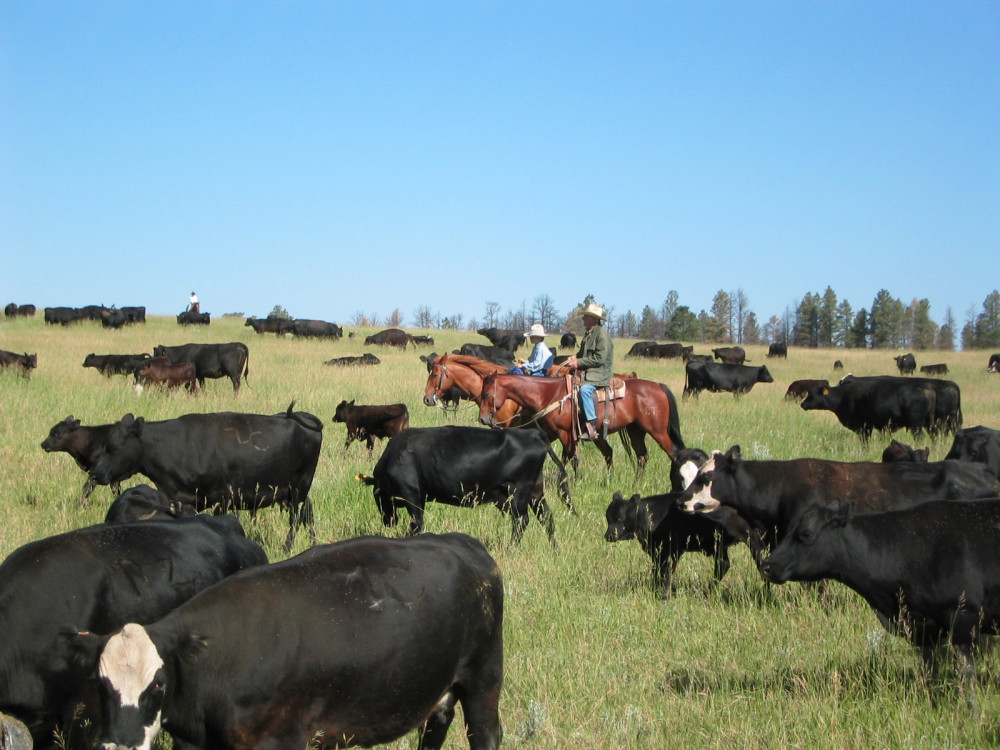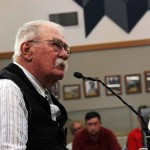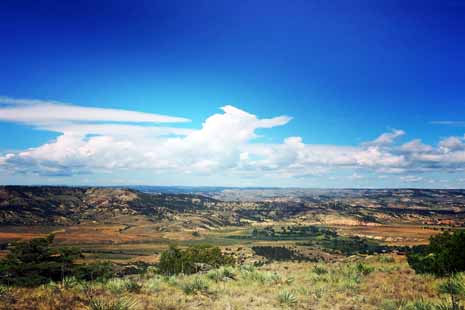I was almost eleven years old in the summer of 1977 when my parents and other members of the Northern Plains Resource Council saw an article in Northern Plains’ newsletter about yet another coal mine proposal. This proposal was close to home.
ITT Resources had bought half the project from a Billings speculator who had been acquiring the rights to coal in the area. The other new owners were utility companies from the state of Washington.

This new mine was to be located near the Tongue River, not far from the town of Ashland. Immediately, ranchers in our area understood that the new mine would need a railroad to transport the coal out of the remote mine site in order to deliver it anywhere. Burlington Northern began a study on hauling coal out of our valley. That was the beginning of the Tongue River Railroad.
From that 1977 announcement until the project’s demise on April 25, 2016, this speculator’s dream hung over ranch families, threatening to cut their property in half through condemnation for a distance of 89 miles. It would have made day-to-day ranch operations more difficult and more expensive, and would have reduced the value of their property. It also would have brought air pollution and noise, chopped up wildlife habitat, and caused wildfires. It would have ruined many Native American cultural sites. We knew that this much disruption to our sparsely populated area would have impacts on the whole valley.
Ranchers like my parents got together with others to form Northern Plains in the early 1970s. It was a big leap for traditionally independent and reticent ranchers to reach out and collaborate with others, but my parents and others knew that the only way we could protect our land and our water was to work together. Northern Plains was formed largely to stand up for people who lived in the path of energy development projects, peoples whose lands and livelihoods were targeted by coal companies and drilling companies.
Today, I am so grateful to the courage and wisdom of people like my parents and so many others who stood up and stood together. We have fought the proposed Tongue River Railroad at every opportunity.
Northern Plains hired technical and legal experts. Members worked with their Northern Cheyenne neighbors, lobbied federal agencies and members of Congress, testified at hearings, and even went to court. It was the kind of work that’s beyond the reach of most individuals, but becomes possible when people work together through an organization.
New Proposals
During those 38 years that the Tongue River Railroad loomed like a dark cloud over Montana ranch country, it would become a moving target, changing its purpose, its route, its destination, and its ownership.
That original coal mine proposed by ITT Resources never moved forward. But the owner of the paper railroad simply found a new purpose.
In the early 1990s, the Tongue River Railroad Company applied for a new permit. With the original coal mine defunct, promoters wanted to add another 42 miles to the original permit to connect with the rail line bringing coal out of Wyoming.

This expanded project would have cut up even more ranchland. It also would have wreaked havoc with railroad workers and towns because the altered rail route would have meant moving crew stations away from towns like Forsyth. It even would have threatened Montana coal mines because, in creating a “short-cut” for Wyoming coal to the Great Lakes, it would have eliminated much of the transportation advantage enjoyed by Montana coal mines.
It would have torn through my family’s ranch, cutting our bull pasture in two. As my Dad said, “We will have two pastures – one with water and one without.”
Northern Plains members, joined by members of the Northern Cheyenne grassroots group, Native Action, along with other individual members of the tribe, the Northern Cheyenne Tribal Council, railroad workers and unions, the small town of Forsyth, Montana, and even local chambers of commerce, fought fiercely against this new proposal.
In those days, The Interstate Commerce Commission, predecessor of today’s Surface Transportation Board, required that comments from the public be submitted in the form of “verified statements” – notarized letters – and that 22 copies of each letter had to be submitted.
Northern Plains organizers drove all over the place, hauling big desktop computers and printers to help local residents write letters, printing them out for people to sign, and then making all those copies back in the Billings office. Northern Plains collected and submitted more than 1,100 verified statements, which added up to 24,000 pages that staffers boxed up and shipped to the Interstate Commerce Commission in Washington, DC. The ICC had never seen anything like it!
But the ICC wasn’t in the business of turning down railroad applications. The Tongue River Railroad won a new permit in 1996, with a 3-year deadline to complete construction. That deadline was never met, but the permit was never rescinded.
More years passed, and the Tongue River Railroad applied to the Surface Transportation Board for yet another permit to build along another new route. The STB granted this new permit. The Tongue River Railroad was a fully permitted railroad – but Northern Plains continued to challenge its permit in court. Northern Plains stayed with the fight and the project languished.
We met every year in the Tongue River Valley to raise money for our fight. These “Birney BBQs” (we held 19 of them over the years, several at our ranch) were more than just fundraisers. They were a chance for all of us to get together to celebrate our valley. These BBQs reminded us locals that we were not in this fight alone.
But, despite our hard work to keep the Tongue River Railroad from being built, the proposal persisted.
What brought this stalled project back into the scene was the State of Montana’s sale of coal leases in the Otter Creek Valley in 2010. Arch Coal had leased additional coal tracts in the valley from Great Northern Properties and, combined with the State’s lease, this gave Arch Coal the rights to mine 1.4 billion tons of coal – a far bigger mine than any other in Montana’s history.
This new mine would export coal westward, to the West Coast, then to customers (speculative, of course) in Asia. And the Tongue River Railroad, in yet another incarnation, would haul that coal to the main rail lines. This new route – announced in December 2012 – would spare our ranch, but it would have been a nightmare for ranchers like the McRaes and other landowners along the route. This new route would have cut the McRae’s Rocker 6 ranch right in half in order to get that coal started on its trip to China and elsewhere in Asia.
New Allies
But this new export plan began to gain attention outside of Montana, for the coal exports would mean dramatically increased coal train traffic through towns all across Montana, Idaho, and Washington. People who had never heard of the Tongue

River valley came to understand how connected our ranchland would be with their cities. Just as Northern Plains members actively testified against the coal export terminals proposed on Washington’s coast, people in the Northwest – along with groups like Power Past Coal – took an active interest in the Tongue River Railroad. After so many years of fighting the Tongue River Railroad (more or less isolated from the public spotlight), our coalition welcomed this new awareness of the Tongue River Valley. Working landscapes like this – while productive, ecologically healthy, rich in wildlife, and full of natural and human history – don’t tend to ignite the public’s passion like special places on public lands.
Northern Cheyenne members built an alliance with the Lummi Tribe, whose small reservation juts into Puget Sound, and whose treaty-protected fishing rights would be harshly impacted by a coal export terminal proposed very near their reservation. The Lummi reached out to those of us working in the places where that coal would come from and, in 2015, Lummi carvers gave the Northern Cheyenne a 22-foot totem pole, adorned with animals symbolic to the Northern Cheyenne. While the Northern Cheyenne are working on a permanent location for the totem pole on their Reservation, Northern Plains is honored to be its caretaker – this beautiful totem pole currently stands outside our office in Billings.
Last year, Northern Plains members testified at every one of the public hearings on the environmental impact statement for the Tongue River Railroad. Working with our allies, we were able to generate more than 322,000 public comments against the Tongue River Railroad!
The Collapse
At the same time, things were falling apart for the coal industry. Cheap natural gas had replaced coal at many power plants. Asian countries began to cut back on coal import plans, especially in China, where intense coal burning had produced world-famous air pollution that was sickening large numbers of people there. And the federal government’s Clean Power Plan – even though it’s not yet in effect – made it clear that the coal industry would no longer be able to shove so many social costs onto the public.
As plans for the Otter Creek strip mine began to disintegrate, the Tongue River Railroad asked the Surface Transportation Board (November 25, 2015) to hold its permit application in abeyance – effectively seeking a “time out.” But Northern Plains responded with a legal petition saying that “enough is enough!” This project has been hanging over the heads of Montana ranch families since 1977, and a decent sense of fairness would not allow such a situation to go on indefinitely.
In mid-April 2016 – after Arch Coal had declared bankruptcy and suspended work on its own permit – Northern Plains learned that Arch had lost the Great Northern Properties portion of its lease months earlier. Our attorneys informed the Surface Transportation Board of that fact, and explained that this meant Arch Coal no longer had access to a mine-able coal deposit (because of the checkerboard ownership pattern of the coal deposits).
Victory!
Then, on April 25, 2016, the Surface Transportation Board issued a decision, denying the Tongue River Railroad’s permit application.
So, is the Tongue River Railroad dead?
This version is. And this we should celebrate! But developers in the future could still come back with another proposal someday. As the coal economy stands today, that’s not very likely.
When something you’ve worked for most of your life finally comes to pass, it can be hard to know how to react. Do we let ourselves think that it’s over? Or do we always keep a bit of caution in our hearts, knowing that someone else could come up with another way to make money by destroying good ranch country.
I’m still thinking this over. Our friend Clint McRae is, too. He told the Great Falls Tribune, “I am guardedly optimistic…It isn’t over, but it’s a hard blow to the railroad.”
It isn’t over, but we have to celebrate this milestone. We have worked too long and hard, and defied such impossible odds!
And Clint McRae, cautious as he might be, has pledged to wear his kilt to this year’s Northern Plains annual meeting in Billings.
It’s been a long haul for a lot of people. Dad is 85 years old now – I have an eleven year-old of my own and I am almost 50.
But we did it! We never could have done it by ourselves but, together, we stopped the Tongue River Railroad! We are grateful.
Before the Tongue River Railroad was even proposed, my mother, Carolyn Alderson (Walker), spoke at an energy symposium in Sheridan, Wyoming, offering a sort of warning to the speculators that threatened ranch land all over southeast Montana:
“My name is Carolyn Alderson. My husband and I own and operate a ranch in Birney, Montana. I am here today as board member of Northern Plains Resource Council… I am here because the history, present, and future of this land and its people are in danger because of the existence of coal…To those of you who would exploit us, do not underestimate the people of this area. Do not make the mistake of lumping us and the land all together as ‘overburden’ and dispense with us as nuisances.”
We will carry those words and that spirit again if the Tongue River Railroad ever comes back to life. We are celebrating today. But we will be ready.
– Jeanie Alderson
This blog post was originally published in Plains Speaking, a blog by members of the Northern Plains Resource Council. Tongue River Valley photography by Jeanie Alderson.

